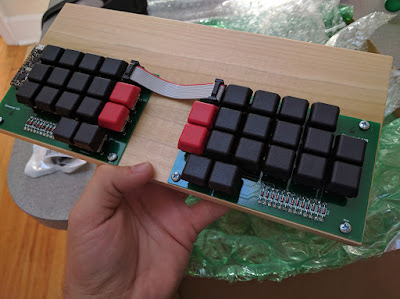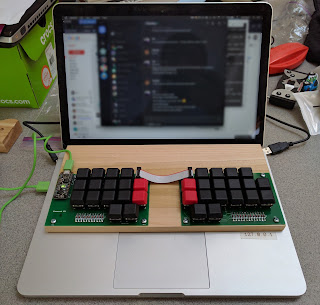Warning: this article may be hard to understand if you are:
- A steno nerd but don't know about mechanical keyboards
- A mechanical keyboard nerd but don't know about steno
- Not a nerd
Today I'm writing to talk about a new steno machine. It's not a Stenograph, or a ProCAT, or an Infinity. In fact, it's not an "anything", it's a homemade writer made by Plover's community member Charley Shattuck. Charley has been making custom steno machines at home for a couple years now, seeking a cheaper solution than what exists on the market. Traditional steno machines have a lot of issues for the casual learner who isn't trying to become a reporter: they are expensive, bulky, need to be powered, and are simply hard to find. The Stenomod is Charley's solution to that problem. It's low cost (relatively), portable, and powered over USB. It's not meant to replace a traditional writer, per se, but rather offer a machine to people who would like to try stenography without taking out a loan. At $200USD, it's shockingly affordable and I'd like to talk about it today after using it for a month, from the perspective of someone who has played with fancy machines.
 |
| First look after unboxing! |
I started steno on a mechanical keyboard, the ErgoDox, then moved on to a Word Technologies Tréal TR, then an Infinity Ergonomic, and I've played with an older LightSpeed. I've also tried the Stenoboard, another low-cost steno machine. I also refer to the SOFT/HRUF, but unfortunately I don't own one! I'll offer my thoughts on the Stenomod in comparison with the others in a few categories. Since I'm writing about the Stenomod, I will compare it to other machines, but might skip ones that I don't think are relevant for the comparison. I'm looking at: writing, portability, price, aesthetic, customizability, and noise.
Writing
The first thing I'm sure many of you will be thinking: does it feel/write like a real steno machine? Well, not really. It's more like a really, really light keyboard than a lever-based steno machine. That's not to say it's a bad thing! It's 35g to actuate a key, which is heavy compared to a lever machine, but it's comparable to the Tréal (technically twice as heavy, but it doesn't feel that way). The nice thing about keys, as opposed to levers, is how easy it is to hit the number bar, as the keys are all the same size. I find that on lever machines the number bar is too far away and too shallow, and sometimes the vowels feel too deep. The Stenomod has uniform travel across all its keys.The layout is split, meaning that your hands are not absolutely stuck together. I find the split layout much more comfortable than a narrow layout like the Treal and LightSpeed. I've mainly used the Stenomod on the wooden deck, because it's convenient to throw the one piece into my bag and sit it on my lap. Taking the machine off the wood (or cutting the wood in half) would let you spread out your hands even further, similar to an ErgoDox.
I don't find that the Stenomod greatly affects my speed while writing. I can write just as fast on it as I can on my other machines. Contrast this with the Stenoboard, which I find myself to be slower on.
The only thing I would change (or at the very least experiment with) would be to try and move the vowel keys further away from the consonants. Right now they are quite close and it took me a little to get used to it.
 |
| The Stenomod fits splendidly on my Macbook Pro 13" |
Portability
Lever machines are almost never portable, with exception to something like the Luminex, which is relatively portable. My portable machines would be the ErgoDox, Stenoboard, Tréal, LightSpeed, and Stenomod. The ErgoDox and Stenoboard are both split, so traveling with it always carries certain difficulty. The ErgoDox has a lot of extra keys because it's a keyboard, so it's much heavier and space-consuming. The Stenoboard is tiny, yet thick, meaning it also takes up bag space. The Tréal is very nice, but the cable is not removable and I worry about it getting bent. The Tréal is also quite thick compared to the Stenomod, about 3 inches instead of 1 and a half. The other thing I really like about the Stenomod's form factor is how I can rest it on my lap and write as long as it's on the wooden deck. I find it easier to sit casually with the Stenomod than the LightSpeed. It may be because the LightSpeed requires great accuracy whereas the Stenomod has leeway for me to accidentally tap another key without actuating it, or to rest my hands in the home position. |
| Me squinting into the sun while stenoing on the 'mod in the local arboretum. |
Price
The Stenomod's $200 price tag puts it among the cheapest options available. It's similarly priced to the Stenoboard, and is only beaten by the SOFT/HRUF, which is at about half the cost. The "real" machines are out of the question, price-wise. The Tréal is the next cheapest machine, four times as expensive at $800. And from there it gets really crazy, where the Infinity, LightSpeed, Luminex, or any other modern steno machine will easily run you $3,000 or more. I can confidently say that you do not get 15 times the performance out of a real steno machine compared to a home-brew one like the Stenomod.Aesthetic
The Stenomod is raw. It comes on a deck of wood, it has exposed circuit boards, and a nice ribbon cable running between the two halves. It looks a little unfinished, but I'll tell you that it is very noticeable. I get comments all the time from people asking how it works, what it is, more so than I did with my Tréal, which looks like a special keyboard. There's something appealing about the raw exposed technology look of the Stenomod, and it's truly grown on me.I'm working on making a 3D-printed case for the Stenomod, which I'm sure will change the aesthetic. Mirabai Knight had some concern about bringing the exposed PCB of the Stenomod on the NYC subway due to the city's "see something, say something" campaign. People are more alert there than in Ottawa where I get friendly passersby asking what the heck I'm typing on.
Customizability
The Stenomod deserves its own category for customizability. You can do a lot to this machine. The deck, the piece of wood that the machine lies on, can be removed and you have a split keyboard. Charley sends two lengths of the ribbon cable with the machine, so you can separate the halves a few feet if you want. The key switches are Gaterons, meaning they have Cherry stems, which you can buy custom key caps for. Right now, I'm experimenting with 3D-printing key caps for it. I could paint the deck, cut it in half, make a custom case, or do anything to make it look how I want. Because the USB cable is removable, I've changed it to a color I like. You could replace the included red and black G20 key caps with another color from Signature Plastics.Even the firmware is customizable. As part of a separate project, we created a custom firmware for the Stenomod where you can use different chorded modes (think fingerspelling without letting go of the asterisk), or chord repeat (like repeated arrow key movements). In some ways, I feel cheated with my expensive steno machines as I cannot customize them nearly as much as the Stenomod.
Noise
The Stenomod is a keyboard, not a lever-based steno machine, so it is naturally relatively loud. It's like any other mechanical keyboard, like the ErgoDox or the SOFT/HRUF, and can be heard well enough in a quiet room. It doesn't click, unlike the Stenoboard, which sounds like harmonious mouse clicking. Here the Tréal, Infinity, and LightSpeed all win over the 'mod. However, for a normal office where someone might use a normal keyboard, the Stenomod is perfectly adequate. I just wouldn't bring it to court or a very quiet lecture.Conclusion
Compared with the other offerings that are similarly priced, I'd say the Stenomod is a great choice. The SOFT/HRUF would be my second choice, though I haven't tried one in person. A couple things give me pause for the SOFT/HRUF: the keys are 100% flat, meaning you might lose your place; the switches are slightly heavier than the Stenomod's; and the thumb key placement doesn't look comfortable to me. The Stenoboard, unfortunately, I found unusable for any appreciable length of time or speed because of the low travel.Of course, the Stenomod is not meant to replace the fancy steno machines that stenographers already have, but one should not ignore it simply because it's not meant to be a court reporting machine. It could be useful for practicing on the go, or as a portable backup machine in a pinch.
Before I received it, I thought the Stenomod would be a fun toy that I could recommend to steno students and hobbyists. However, I find its form factor so convenient that I end up bringing it with me most places. It's quick to setup, easy to throw into my bag, and fun to show off. I would recommend a Stenomod to anyone learning steno who wants a machine to improve on without breaking the bank.
You can buy one from the Stenomod Blogspot website.
As a disclaimer, Charley sent me one of the first Stenomods for free to test out. He didn't request a review; I wrote this because I wanted to share my thoughts on the machine. In return for the free machine, I've been helping out with graphic design as well as the key cap and case models I've been experimenting with.
